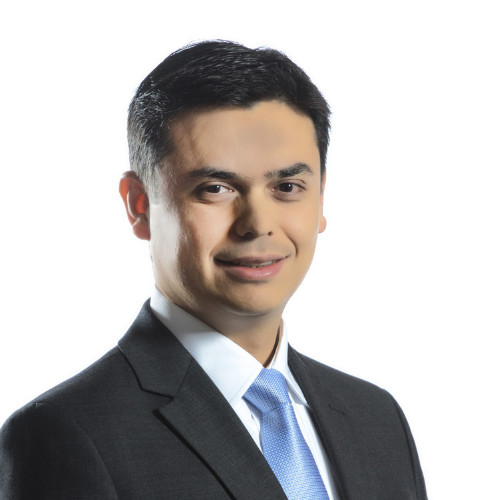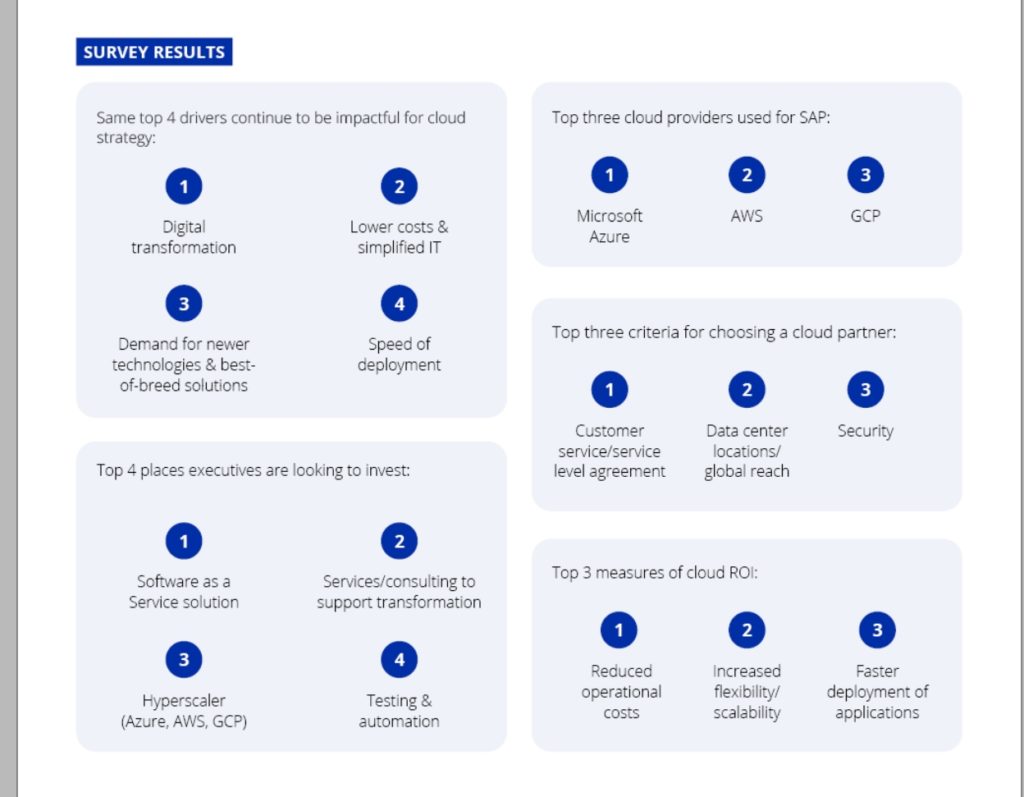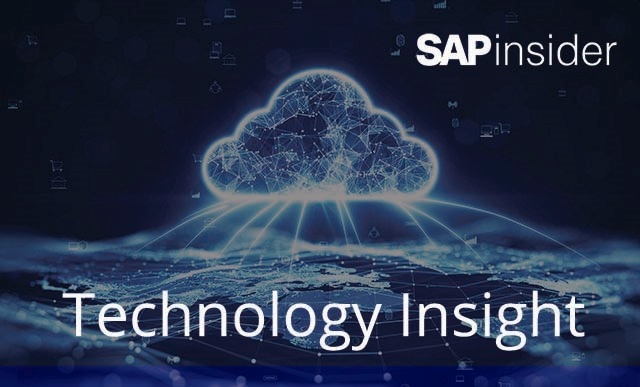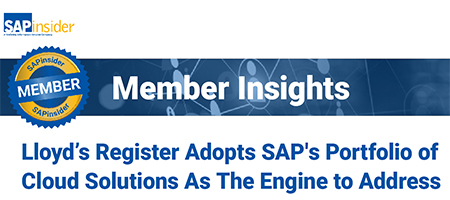Cloud Decisions for Executives Who Run SAP
By Brianna Shipley, Editorial Director
“It’s not a matter of if or when you’re going to the cloud,” said SAPinsider’s Riz Ahmed, Chief Content Officer, during the opening of our November Executive Meeting. “Most people we’ve talked to are already there. It’s now a question of what’s next, and how does that relate to SAP workloads?”
Ahmed prepared attendees for a discussion about cloud decisions by reviewing a few research points. (See Survey Results at the bottom.)
Explore related questions
We were honored to host executive speakers from around the world. The following technology leaders shared stories about their cloud journeys and decision-making processes:
- Roberto Oikawa, CIO, Casa dos Ventos (Brazil)
- Steve Birgfeld, VP Information Technology & Services, Blue Diamond Growers (US)
- Hernan Guerra, CIO and Head of HR, Viakem (Mexico)
- Ralph Michaelis, Canadian Blood Services (CBS) (Canada)
A Public Cloud Story
Oikawa is the CIO of the biggest wind generator in Brazil. The name of his company, Casa dos Ventos, means “house of the winds,” explained Oikawa. The wind market is opening and growing, and Oikawa carries a big responsibility: To prepare the company to compete in this changing environment, where more businesses will have access to buy and sell energy contracts in the open market.

Casa dos Ventos made the move to SAP S/4HANA on Google Cloud Platform (GCP) as part of its expansion, and so began this public cloud story.
Oikawa explained that in order to get the most potential out of the company’s public cloud investment, he studied GCP’s architecture and adapted the company’s processes and technologies accordingly.
Moving from Infrastructure-as-a-Service to the serverless architecture of the public cloud required a change of mindset and significant training.
Oikawa said that GCP is the “center of gravity” for all SAP and non-SAP workloads for Casa dos Ventos. To support the platform, a best-of-breed cloud architect was required. Oikawa emphasized that a critical success factor was hiring this skilled role in-house to serve as an internal advocate in the cloud migration. Oikawa changed the entire profile of his IT team, he explained, hiring staff with a capacity for continuous learning and driven by knowledge. Cloud skill sets are difficult to find, so be prepared to provide training, he said. Oikawa provided certification voucher programs to his staff.
“Are there any cost-related surprises with public cloud?” asked Ahmed. Oikawa responded that the cost of data outages was unexpected and remains a gray zone for the company. But he said his company couldn’t justify a move to the cloud on cost alone. By gaining infrastructure support from its hyperscaler partner, the IT staff at Casa dos Ventos can now focus on business requirements and the innovation capabilities of the cloud, as well as efficiency opportunities and speed to market (Read the full story here).
A Private Cloud Story
Before Birgfeld, Blue Diamond Growers didn’t have a CIO. In 2016, he became the first, and in this private cloud story, Birgfeld shared how the California-based, agricultural cooperative and marketing organization set the foundation for business enablement by taking a brownfield implementation approach to SAP S/4HANA on the private cloud.

Birgfeld’s investment in skills focused on cloud orchestration — or as he defined it, the movement of data across systems — to solve the company’s biggest challenge: integration. Blue Diamond hired an SAP functional team to properly configure integration between applications like SAP Ariba and SAP S/4HANA, said Birgfeld, while also pulling data from SAP Integrated Business Planning into SAP HANA Cloud.
Birgfeld shared that moving from a SQL server platform to SAP HANA Cloud reduced the company’s data footprint by 30%.
Birgfeld also emphasized the importance of selecting the right managed service provider. In 2020, the company switched partners based on factors like:
- Level of flexibility and capacity for support
- Total cost of ownership
- Minimized downtime.
Birgfeld said he considered the hyperscalers but has decided not to work with them at this time. His managed service provider allows the company to take advantage of “burst mode capabilities” like turning off dev environments when not in use to minimize costs.
Now, Birgfeld said he is looking at burst capabilities of Google Cloud Platform at the prompting of his current partner and moving to a hybrid environment. One that can allow the company to explore emerging tech like the Internet of Things while still maintaining partial management of his infrastructure with private cloud.
Key Cloud Decision Points and Culture Change
During the executive panel, Viakem’s Guerra and Canadian Blood Services’ Michaelis answered questions about how their companies are making decisions about the cloud.
Guerra projects that Viakem will implement SAP S/4HANA by 2023. He says the company is currently running its servers on-premise, with its back-up — containing more than 20 years of information — on private cloud. By early 2022, he hopes it can be vice versa.

What considerations will impact the ultimate decision? According to Guerra, the pricing to continue using private cloud for this purpose is higher than expected — 40–45% higher than public cloud options like Microsoft and AWS compared to the expected 20–30%. Guerra speculated that this is due to security costs. (Read about how Guerra built an AI-based application to help support the company’s interview process here.)
While Guerra weighs costs to decide which type of cloud environment his company will use in the future, Michaelis is investing in a different kind of cloud strategy: One of careful preparation.
Before moving the entire infrastructure to the cloud, Michaelis is using a cloud-based planning solution, SAP Integrated Business Planning, to help solve two main pain points for the business: planning and forecasting, and inventory management and control.

He explained that CBS is modernizing its supply chain processes, co-creating with the business, and practicing innovation in short bursts all in preparation for SAP S/4HANA and the cloud. Read more about Michaelis’ approach here.
From a change management perspective, Guerra said that explaining which specific steps and daily operations would change, especially for the help desk, was critical for a smooth transition to the cloud. Being clear that the team would need to follow a different process and understanding from their service provider what those changes looked like, was an important change management component.
Michaelis said that CBS’ transformation is currently focused on areas like service and quality management. These changes and adjustments are preparing staff for what will be required with an eventual cloud migration.
In fact, the nature of the organization has changed, said Michaelis. Organizing around technology wasn’t helping, so Michaelis turned it inside out. He’s created an external and an internal customer experience group, which he said is helping the organization to think differently and work its adaptation muscle. Because, frankly, he said, “cloud changes your whole delivery and development models. If you don’t prepare people appropriately to make that transformation, it really isn’t going to succeed in the long term because they’re going to keep reverting back to old behavior.”
What Does This Mean for SAPinsiders?
The following lessons about cloud came out of SAPinsider’s November executive meeting:
- Understand how other technology executives are approaching the cloud by attending interactive and networking events with your peers. SAPinsider’s Executive Roundtables are small virtual gatherings of technology executives brought together to discuss strategic priorities and solutions. Each roundtable will have a dedicated topic and include a case study presentation followed by a facilitated discussion. These roundtables are for executives from practitioner organizations who are SAP end-users. Registration is subject to approval. Register here.
- Emphasize on experience, not technology. Michaelis found that organizing his teams around the technology upgrades wasn’t working. Instead, he created two customer experience groups: One focused internally, and one focused externally. This is allowing his team to practice change before CBS migrates to the cloud. By introducing change and innovation in short bursts, you can build trust that new features, releases, and upgrades can mean a positive impact for people and the business, while easing your team into the pace of change. Taking a page out of Guerra’s book, keep in mind too the impact on process. Explain to your team that change is required and clarify how its daily operations will be impacted.
- Think outside of the typical profile when hiring IT staff. The classic IT skill profile is someone with developer and programming skills. But Oikawa identified a new characteristic that is needed for today’s technology teams: a capacity for continuous learning. Hiring professionals who understand business acumen and are willing to learn more, and pivot to new technologies as they arise, is essential to developing an agile team and resilient business model. When moving to the cloud, Oikawa also emphasized the need for a best-of-breed cloud architect and training in-house staff on cloud skills.
- Consider burst and innovation capabilities that a hybrid environment can unlock. Birgfeld said his company isn’t ready to move all of its workloads to the public cloud, but he acknowledged the benefits of hyperscalers and their burst capabilities. Implementing a hybrid environment will allow him to manage certain parts of his infrastructure while experimenting with emerging tech like IoT. SAPinsider’s research confirms that Birgfeld’s discriminatory approach to where he hosts his workloads is growing in popularity. When asked about their cloud strategy for SAP S/4HANA deployment, slightly more respondents in 2021 compared to 2020 said they are planning a hybrid deployment with some on-premise and some private cloud instances.
Key Takeaways from SAPinsider 2021 Research
- Make cloud a key part of your ongoing IT and business strategy
- Leverage core measures to show effectiveness of your current cloud strategy
- Go beyond just cost and efficiency
- Do not ignore the innovation potential of the cloud
- Establish processes, culture, and mindsets to scale cloud
- Use SAP S/4HANA as an accelerator for your cloud decision-making
- Build scalable integration strategy early
Survey Results and Research Points









